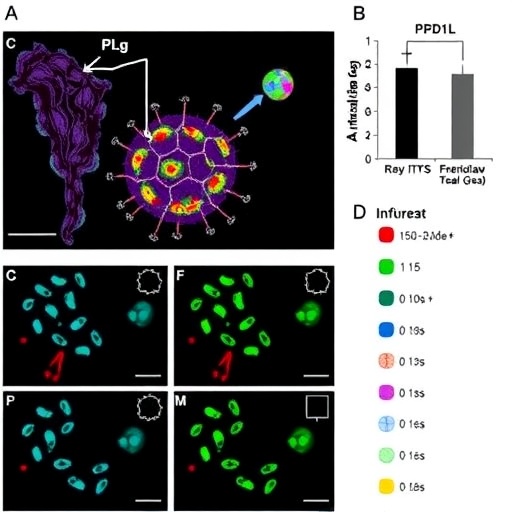In the ever-evolving realm of cancer research, scientists are pursuing novel strategies to combat the complexities of malignancies, with lung cancer remaining a significant challenge. In a groundbreaking study, researchers have explored the synergistic potential of two compounds, B-AP15 and the HSP90 inhibitor tanespimycin, illuminating their role in inducing reactive oxygen species (ROS)-mediated cytotoxicity in human lung cancer cells. This innovative research sheds light on a promising therapeutic avenue, suggesting new possibilities for targeted treatments that harness the power of these compounds.
The study, conducted by a team of leading scientists, represents a significant step forward in understanding the cellular mechanisms through which cancer cells can be effectively targeted and eliminated. Lung cancer is notoriously difficult to treat, often due to its late diagnosis and the development of resistance to conventional therapies. However, the combination of B-AP15, known for its proteasome-inhibiting properties, with tanespimycin, an HSP90 inhibitor, showcases a compelling strategy to overcome these hurdles.
B-AP15 has garnered attention for its unique ability to disrupt the proteasomal degradation pathway, leading to the accumulation of proteins that promote cell death in cancerous cells. When used in conjunction with tanespimycin, which interferes with heat shock protein 90 (HSP90) function, the duo works to enhance the effects of ROS, a type of highly reactive molecule that can cause oxidative damage in cells. This mechanism appears to be particularly effective in lung cancer, where these pathways are altered to support tumor growth and survival.
The researchers utilized a range of experimental models to elucidate the effects of the B-AP15 and tanespimycin combination on lung cancer cells. The results demonstrated that this powerful combination not only induced significant levels of ROS but also triggered apoptosis, the process of programmed cell death, in cancer cells. This finding is particularly noteworthy, as apoptosis is a natural barrier to tumor progression, and its induction could translate into reduced tumor aggressiveness and improved patient outcomes.
Moreover, the research underscores the importance of understanding the role of the tumor microenvironment in the efficacy of these treatments. The combination of B-AP15 and tanespimycin appears to alter the tumor microenvironment in such a way that enhances the cytotoxic effects of ROS. This intricate interplay suggests that the success of cancer therapies may hinge not solely on targeting the cancer cells themselves but also on manipulating the surrounding microenvironment to inhibit tumor growth.
Through their rigorous investigations, the authors of this study have provided compelling evidence that the B-AP15 and tanespimycin combination could lead to a paradigm shift in the treatment of lung cancer. As the research community continues to unravel the complexities of cancer biology, the integration of both targeted therapies and traditional approaches may offer new hope for patients with this devastating disease.
The implications of this study extend beyond the laboratory, highlighting the urgent need for clinical trials to assess the safety and efficacy of this combination therapy in human populations. By transitioning from preclinical findings to clinical applications, there is potential for a significant impact on treatment regimens for lung cancer patients. The progressive notion of using ROS-mediated mechanisms aligns with the ongoing quest for more effective, less toxic cancer therapies.
Another fascinating aspect of the research is its contribution to the broader landscape of combination therapies in oncology. The strategy of pairing two or more agents that target different pathways may offer a synergistic advantage, enhancing therapeutic efficacy while minimizing resistance. With lung cancer’s complex biology, this approach could prove to be a crucial component of future treatment protocols.
As researchers continue to investigate the intricacies of ROS and its relationship with various cancer therapies, the results of this study pave the way for further exploration. Understanding how distinct compounds interact and with what mechanisms enables scientists to design more refined, targeted strategies that can address the myriad of challenges posed by cancer treatments.
In conclusion, this research highlights a novel therapeutic approach that leverages the strengths of B-AP15 and tanespimycin to induce ROS-mediated cytotoxicity in lung cancer cells. The compelling findings bring a new level of optimism in the field of cancer research, suggesting that strategic combinations could lead to groundbreaking therapies for patients battling this formidable disease. As advancements continue to unfold, the hope remains that these innovative strategies will contribute to improved survival rates and quality of life for lung cancer patients.
The ongoing pursuit of a deeper understanding of cancer biology and therapeutic modalities is essential. With continued dedication from researchers and clinicians alike, novel solutions are on the horizon. The fusion of scientific innovation and clinical application presents an exciting future in the landscape of cancer treatment, ultimately aimed at providing more effective therapies while reducing the burdens that accompany malignancies such as lung cancer.
As we look forward to future studies, the collaboration between scientists worldwide will be essential in harnessing these findings. The potential for implementing ROS-mediated therapies in clinical settings signals a turning point, pushing the boundaries of what is possible in the fight against cancer. With the foundation laid by this investigation, the door is wide open for a wave of new discoveries that could transform lives.
Subject of Research: Combination of B-AP15 and HSP90 inhibitor tanespimycin in human lung cancer cells.
Article Title: Combination of B-AP15 and HSP90 inhibitor tanespimycin induces ROS-mediated cytotoxicity in human lung cancer cells.
Article References:
Fu, W., Lu, H., Yan, Y. et al. Combination of B-AP15 and HSP90 inhibitor tanespimycin induces ROS-mediated cytotoxicity in human lung cancer cells.
BMC Pharmacol Toxicol 26, 177 (2025). https://doi.org/10.1186/s40360-025-01009-8
Image Credits: AI Generated
DOI:
Keywords: lung cancer, ROS, B-AP15, HSP90, tanespimycin, cytotoxicity, combination therapy.
Tags: B-AP15 and tanespimycin combinationcytotoxicity in lung cancer cellsHSP90 inhibitor researchinnovative cancer research breakthroughslung cancer treatment strategiesmechanisms of cancer cell deathnovel cancer therapiesovercoming cancer drug resistanceproteasome inhibition in cancerreactive oxygen species inductiontargeted lung cancer therapiestherapeutic approaches for lung cancer





